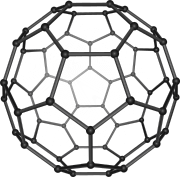The emergence of nanotechnology as a field in the 1980s occurred through convergence of Drexler's theoretical and public work, which developed and popularized a conceptual framework for nanotechnology, and high-visibility experimental advances that drew additional wide-scale attention to the prospects of atomic control of matter. In the 1980s, two major breakthroughs sparked the growth of nanotechnology in the modern era. First, the invention of the scanning tunneling microscope in 1981 which provided unprecedented visualization of individual atoms and bonds, and was successfully used to manipulate individual atoms in 1989. The microscope's developers Gerd Binnig and Heinrich Rohrer at IBM Zurich Research Laboratory received a Nobel Prize in Physics in 1986.[10][11] Binnig, Quate and Gerber also invented the analogous atomic force microscope that year.
Second, fullerenes were discovered in 1985 by Harry Kroto, Richard Smalley, and Robert Curl, who together won the 1996 Nobel Prize in Chemistry.[12][13] C60 was not initially described as nanotechnology; the term was used regarding subsequent work with related carbon nanotubes (sometimes called graphene tubes or Bucky tubes) which suggested potential applications for nanoscale electronics and devices. The discovery of carbon nanotubes is largely attributed to Sumio Iijima of NEC in 1991,[14] for which Iijima won the inaugural 2008 Kavli Prize in Nanoscience.
In the early 2000s, the field garnered increased scientific, political, and commercial attention that led to both controversy and progress. Controversies emerged regarding the definitions and potential implications of nanotechnologies, exemplified by the Royal Society's report on nanotechnology.[15] Challenges were raised regarding the feasibility of applications envisioned by advocates of molecular nanotechnology, which culminated in a public debate between Drexler and Smalley in 2001 and 2003.[16]
Meanwhile, commercialization of products based on advancements in nanoscale technologies began emerging. These products are limited to bulk applications of nanomaterials and do not involve atomic control of matter. Some examples include the Silver Nano platform for using silver nanoparticles as an antibacterial agent, nanoparticle-based transparent sunscreens, carbon fiber strengthening using silica nanoparticles, and carbon nanotubes for stain-resistant textiles.[17][18]
Governments moved to promote and fund research into nanotechnology, such as in the U.S. with the National Nanotechnology Initiative, which formalized a size-based definition of nanotechnology and established funding for research on the nanoscale, and in Europe via the European Framework Programmes for Research and Technological Development.
By the mid-2000s new and serious scientific attention began to flourish. Projects emerged to produce nanotechnology roadmaps[19][20] which center on atomically precise manipulation of matter and discuss existing and projected capabilities, goals, and applications.

No comments:
Post a Comment